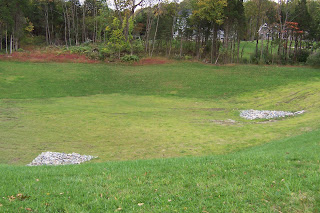Gardening for Birds

(Photo courtesy of Chandler S. Robbins)
My new favorite bird book is Sally Roth’s Bird-by-Bird Gardening, which I stumbled across at the bookstore yesterday. I say stumbled because, although it was faced out on the shelf, it was a bottom shelf and, being the only copy, was pushed to the rear and hidden by its neighbors. Lucky for Sally that I am one of those persistent book buyers who crawls around on her hands and knees to make sure she hasn’t missed anything important. This book deserves a featured position.
It groups birds by families, such as all thrushes together, and all woodpeckers together, etc. While it primarily covers backyard songbirds (not ducks, or hawks, or owls), each chapter details the range and habits of that bird family, habitat, what they look for in a compatible back yard, their natural foods, nesting habits, and what they like at feeding stations. There is a basic garden plan for each chapter, a chart of "surefire plants" to attract that family of birds, and a "top to-dos" section to help get started right away. There are tidbits of information you never knew (or thought about) such as, that the bluebird is the only member of the thrush family that is a cavity nester. It and the varied thrush are the only thrushes that regularly dine at feeding stations. I particularly like the excellent photos of the birds themselves.
While it seems obvious now, thinking about the birds in related groups drew together, in a more organized way, all of the disparate facts I already knew. It was fun to recognize what a variety of birds we already host and that it would take only a few minor adjustments to catch the attention of those that have been elusive.
The book also answered some questions I’ve had for years, such as why the orioles (Baltimore and Orchard) love our blooming apple and oak trees so much. It isn’t the flowers; it’s the bugs!
But the biggest surprise was discovering all of those things we were unconsciously doing right. For instance, those annoying wild grapevines that blot out the sun. I never cut them down because they are the same ones, occupying the same spots that they did when I was a child swinging on them like Tarzan. That maddening pokeweed forest just outside my window that I’ve been reluctant to eradicate because the robins flock to it, turns out to be a favorite of the elusive bluebird, as well. And the now out-of-control mulberry tree out back that Dan planted because Grandma Mabel always had one, turns out to be a bird magnet.
My preference has always been for a naturalized landscape, and the slightly messy appearance of the woods beyond the garden seems a small price to pay in exchange for the teeming wildlife we enjoy.

